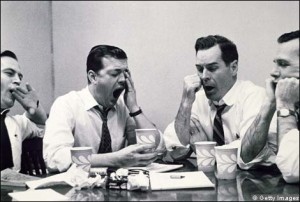YAWNING
VIII. Melanocortins: ACTH and aMSH
A. ACTH and aMSH synthesized as a part of Pro-Opiomelanocortin (POMC: 241 aa)
1. POMC cleaved into ACTH (adrenocorticotropic hormone or corticotropin: 39aa)
a-MSH (melanocyte stimulating hormone: 13 aa)
CLIP (21aa), b-MSH (18aa), g-MSH (11aa), b-lipotropin (88aa), g-lipotropin (55aa)
met-enkephalin (5 aa) and b-endorphin (31 aa)
a. all peptides secreted from the pre-POMC
concommitantly
i. different peptides are secreted
by cleaving POMC in different spots
ii. presence of specific enzymes in secretory vesicles
determine which peptide is manifest
1) prohormone convertase 1 (PC1)
prohormone convertase 2 (PC2),
carboxypeptidase E (CPE)
peptidyl a-amidating monooxygenase (PAM)
N-acetyltransferase (N-AT)
prolylcarboxypeptidase (PRCP)
iii. Cleavage at Arg-Lys, Lys-Arg, or Lys-Lys sequences
b. a-MSH is cleaved from 1-13 ACTH
2. POMC is synthesized in hypothalamus and brainstem
a. POMC is dynamically expressed in the developing forebrain,
midbrain, hindbrain, spinal cord, and retina
i. POMC expression in most embryonic brain regions
is transient
b. POMC production in dorsomedial hypothalamus: arcuate nucleus
i. ACTH & a-MSH made in the arcuate nucleus
ii. ACTH fibers have been found in hypothalamus
amygdala, cortex, brainstem and cerebellum
1) ACTH fibers in PVN and CeA
2) ACTH fibers found in PAG, dRN, LC, NST
c. POMC produced in the nucleus of the solitary tract (NST)
3. Hormonal POMC, ACTH and a-MSH synthesized
and secreted from the pituitary gland
a. ACTH from corticotropes in the adenohypophysis
i. adenohypophysis = pars distalis = anterior pituitary
b. a-MSH melanotropes in intermediate lobe
c. placenta
4. POMC/ACTH/a-MSH also found in female reproductive tract, ovary, testes
GI tract, lung, and immune cells (platelets and lymphocytes)
5. CRH, AVP, OT, NE, Epi, VIP, histidine-isoleucinamide, and angiotensin II
all stimulate pituitary secretion of POMC-derived peptides
B. Melanocortin Receptors: MC1-5 rhodopsin family of 7-transmembrane G protein-coupled receptors
1. MC1 binds a, b, gMSH
a. hormonal receptor on melanocytes Þñ darkening
b. 2nd messenger: Gs ® AC ® cAMP ® PKA Þ CREB Þ CRE
i. GRB2 ® Sos ® Ras ® Raf1 ® MEK ® ERK Þ CREB other TFs
2. MC2 is specific (high affinity) membrane receptor for ACTH
a. hormonal receptor in adrenal cortex Þñ corticosteroids (B/F)
i. pulsatile secretion of B/F
c. 2nd messenger: Gs ® AC ® cAMP ® PKA Þ CREB Þ CRE
d. ñ cAMP ® ñ transport of free cholesterol
to a mitochondrial P450scc
i. ñ RNA, protein synthesis,
phosphorylation and dephosphorylation
e. Ca++ dependent
3. MC3 binds both ACTH and aMSH
a. found in the brain and pituitary (negative feedback)
b. 2nd messenger: Gs ® AC ® cAMP ® PKA Þ CREB Þ CRE
4. MC4 binds aMSH in medulla and pons
a. involved in feeding behaviour, regulation of metabolism,
sexual behaviour, and male erectile function
i. MC4R gene mutations associated with inherited
human early-onset obesity
b. 2nd messenger: Gs ® AC ® cAMP ® PKA Þ CREB Þ CRE
5. MC5 binds a-MSH, but has unknown function
C. Hormonal regulation and functions of ACTH
1. CRF (CRH) is by far the most potent stimulator of ACTH release
a. Potentiation of CRF
i. other ACTH secretogogues, especially AVP,
synergistically enhance the effect of CRF
ii. AVP neuron terminals in the median eminence
(1) colocalized in PVN with CRF
b. CRF is not a very potent releaser of a-MSH
2. 1o hormonal function of ACTH is production & release of glucocorticoids
from zona fasciculata of the adrenal cortex
a. lipolysis
i. as are other POMC fragments
b. ACTH enhances catecholamine production
D. Hormonal regulation and functions of a-MSH
1. Epi/NE stimulate a-MSH release
a. DA inhibits a-MSH
2. a-MSH stimulates dispersal of melanin in melanocytes
a. skin, pelage, and plumage seasonal color change
i. regulated by circannual rhythms
E. Neural/Behavioral effects of ACTH
1. modulation of learning and memory processes
2. facilitaion of arousal
a. behavior associated with stress
i. prevents stress-induced gastric lesions
1) modulate gastric mucosal integrity in response to stress
b. sexual behavior
i. ¯ pituitary LH secretion
c. locomotion
d. aggression
e. grooming
3. homeostasis
a. blood pressure
b. thermoregulation
c. ACTH Þñ CeA MC3 receptors modulate CRF gene expression
i. ACTH potently Þò CRF expression in CeA
4. analgesia
5. used as a treatment for infantile seizures
6. aging
F. Neural/Behavioral effects of MSH
1. influences learning, memory and attention
2. increases sensitivity and augment arousal
a. behavioral effects associated with stress
i. Þñ novelty-induced defecation
1) Þò whole brain [DA] and [NE]
3. Þò appetite
IX. Regulating Yawn Gating
